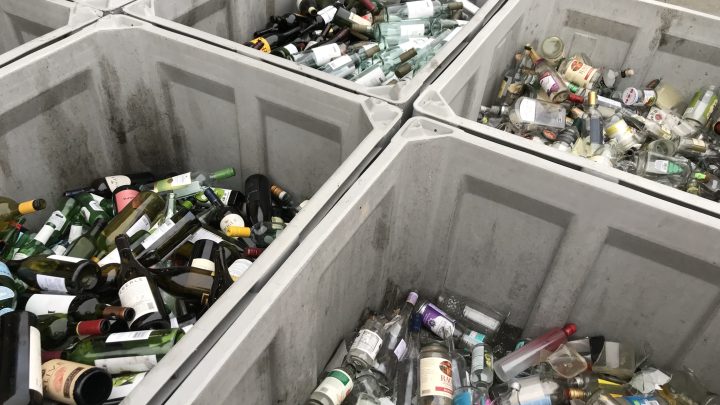
California set to enforce recycled content mandates for plastic bottles
California set to enforce recycled content mandates for plastic bottles

Each year, beverage companies in the U.S. produce 100 billion plastic bottles, and the vast majority go unrecycled. In response, California recently passed a slew of laws that target plastic waste.
One law — which the state is scheduled to start enforcing in January — requires beverage makers to use some recycled materials in single-use plastic bottles.
Proponents say the law expands the market for post-consumer plastics and shifts some of the responsibility for recycling plastic onto the companies that produce it.
At the Burbank Recycle Center in Southern California, workers sort through a stream of mostly paper and plastic, all carried by conveyor belt from a giant pile beneath them to the platform where they stand.
The pile reaches about 15 feet high and takes up much of the warehouse. Its contents were trucked there as part of California’s recycling program.
Recycling specialist Amy Hammes says they have to remove problematic, even dangerous, items like batteries and isolate things that hold value.
“The biggest thing you will see is cardboard,” Hammes says. “And that’s really grown in the last decade because of online shopping.”
That cardboard is lucrative for the facility. What’s not lucrative are the tons of plastic bags and wrap that are mixed in.
“Not only is it something we can’t sell, it tangles in our sorting equipment. It gets dirty. It’s the leading thing of what we don’t want,” Hammes says.
Plastic is lumped into seven categories. Plastic No. 1 is used to make things like soft drink bottles, along with juice and produce containers. Plastic No. 2 goes in milk jugs and detergent bottles.
“And then Plastic No. 5 is kind of an emerging plastic that has some value in some instances. But No. 1 and No. 2 are really the moneymakers in plastic,” Hammes says.
From here, those plastics are packaged into bales and sold off, ending up in carpets, clothing and other products.
But most of the rest — even products bearing the recycling logo — can’t be recycled or sold by traditional programs, Hammes says. So they end up in landfills and waterways.
That problem caught the attention of California Assemblyman Phil Ting six years ago, when his daughter was in the fourth grade.
“Her teacher asked them all to watch a video about a huge dump of plastic just sitting in the middle of the ocean,” Ting said. “It was just crazy to think that we couldn’t do something about it.”
Ting, a Democrat who represents the San Francisco area, is co-sponsor of Assembly Bill 793, enacted last year and soon to be enforced. It requires beverage companies to use 15% recycled material in plastic bottles in the state’s container deposit program. Ting said the mandate rises to 50% by 2030.
“We are such a big market that if they’re going to do it for California, it just becomes easier and easier to do it for other parts of the United States,” Ting said.
One of the world’s largest producers of plastic waste — Coca-Cola — told Marketplace that its plastic packaging portfolio in California is already in compliance with the law.
It used an average of 17% recycled content in 2021. Both Coca-Cola and its rival, PepsiCo — which didn’t respond to Marketplace’s inquiries — say they aim to reach 50% recycled content globally by 2030.
Nestle also said its portfolio of applicable plastic beverage bottles distributed in California incorporates a minimum of 15% recycled content, adding that it continues to work toward meeting the 2030 requirement of incorporating 50% recycled content.
The new law is better than companies’ promises, per Susan Collins, president of the Container Recycling Institute. She expects it will spur change by growing the market for used plastic.
“There will now be much more competition because the beverage companies will have to prove that they’re putting 15% recycled content into their beverage bottles in California,” she said.
This will give beverage companies a financial reason to push for recyclable plastic bottles to actually be recycled. The American Beverage Association, a trade group, says the industry is also redesigning plastic bottles to be fully recyclable.
The recycled content law also helps recyclers, Collins said, that are exposed to their product’s price volatility.
“If times are good, they can survive. And then, when there’s a downturn in the price of recycled material, a lot of them go out of business,” Collins said.
But proponents acknowledge boosting recycled content is just one step towards dealing with plastic waste. The International Energy Agency expects plastic production to double by 2040.
There’s a lot happening in the world. Through it all, Marketplace is here for you.
You rely on Marketplace to break down the world’s events and tell you how it affects you in a fact-based, approachable way. We rely on your financial support to keep making that possible.
Your donation today powers the independent journalism that you rely on. For just $5/month, you can help sustain Marketplace so we can keep reporting on the things that matter to you.











